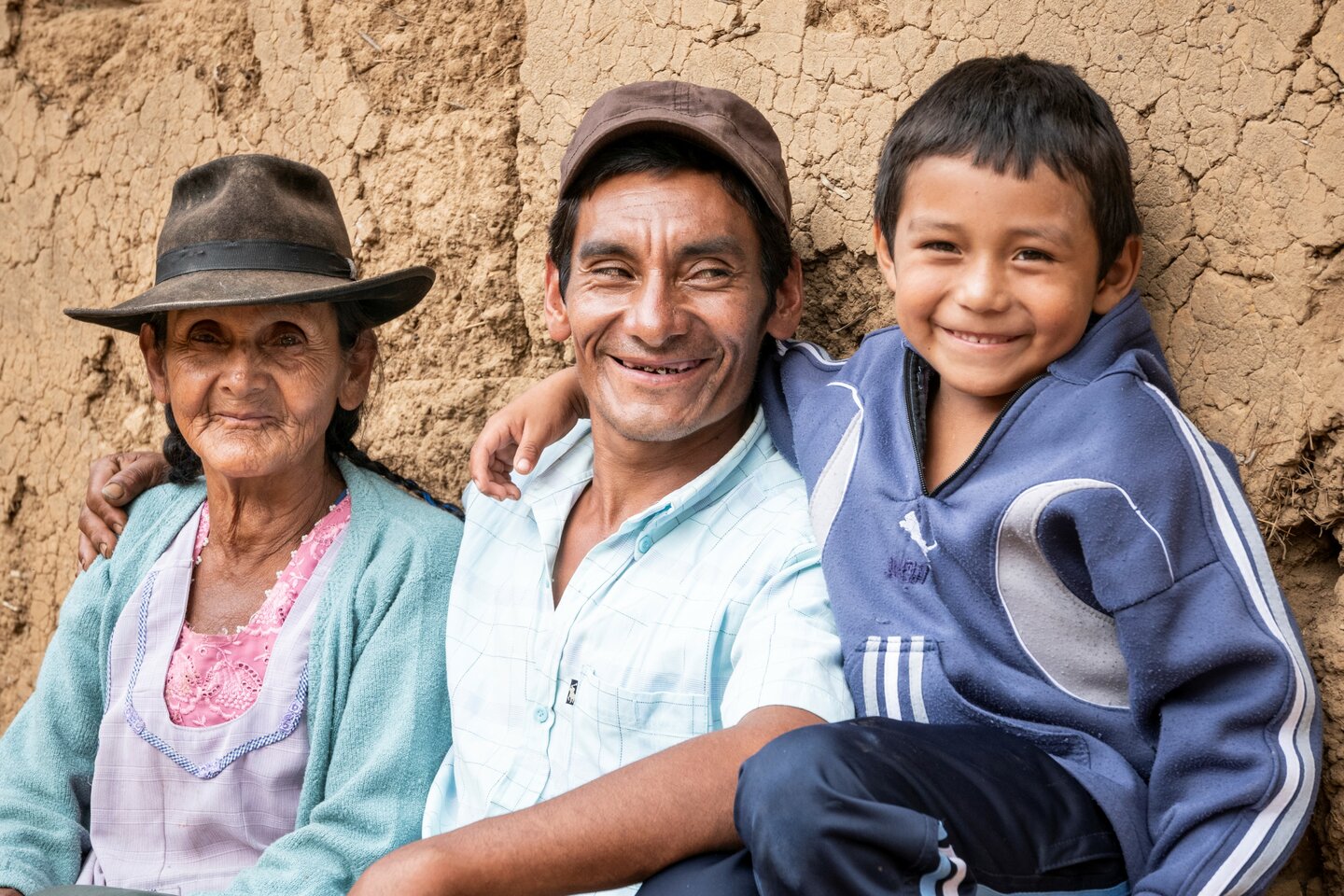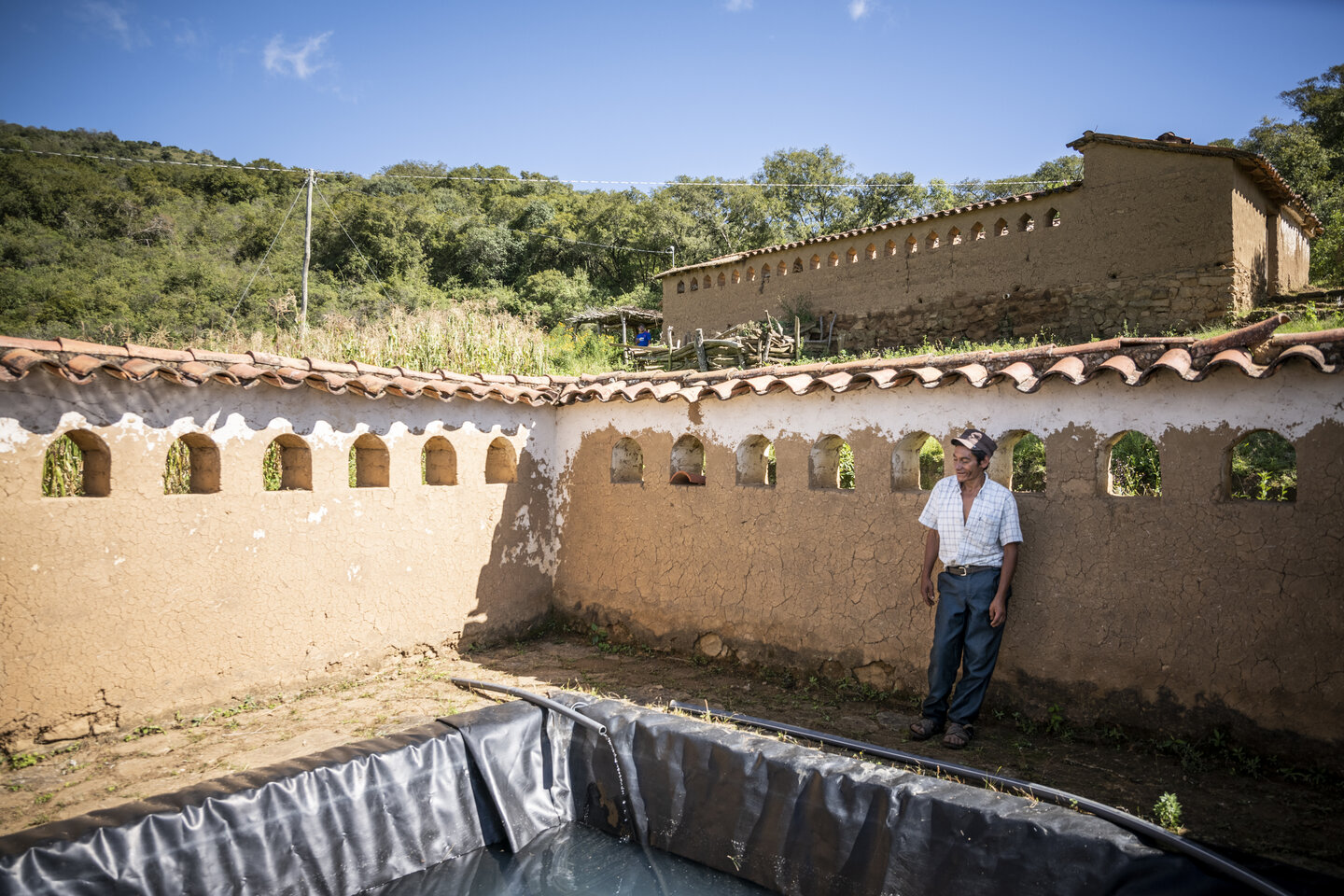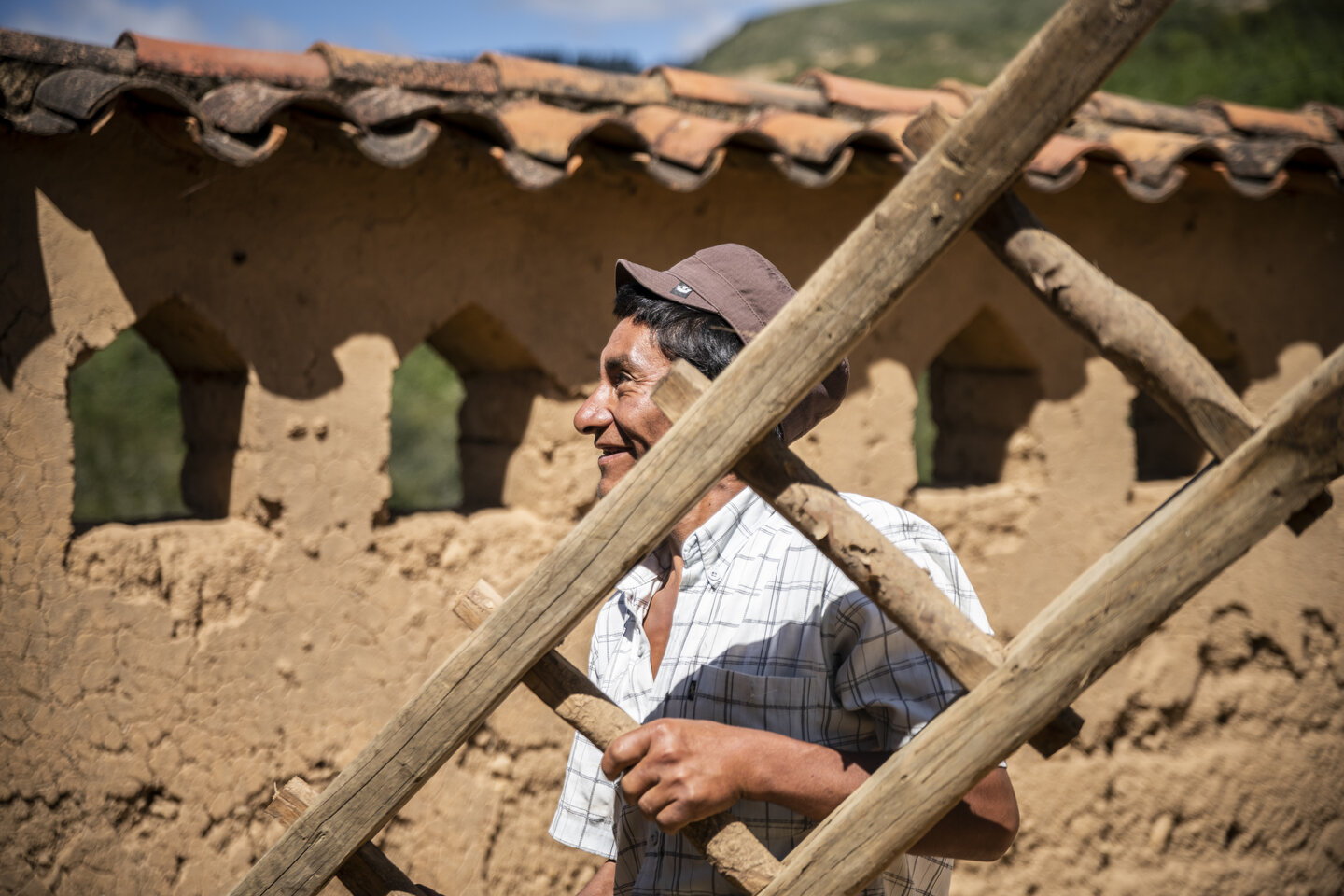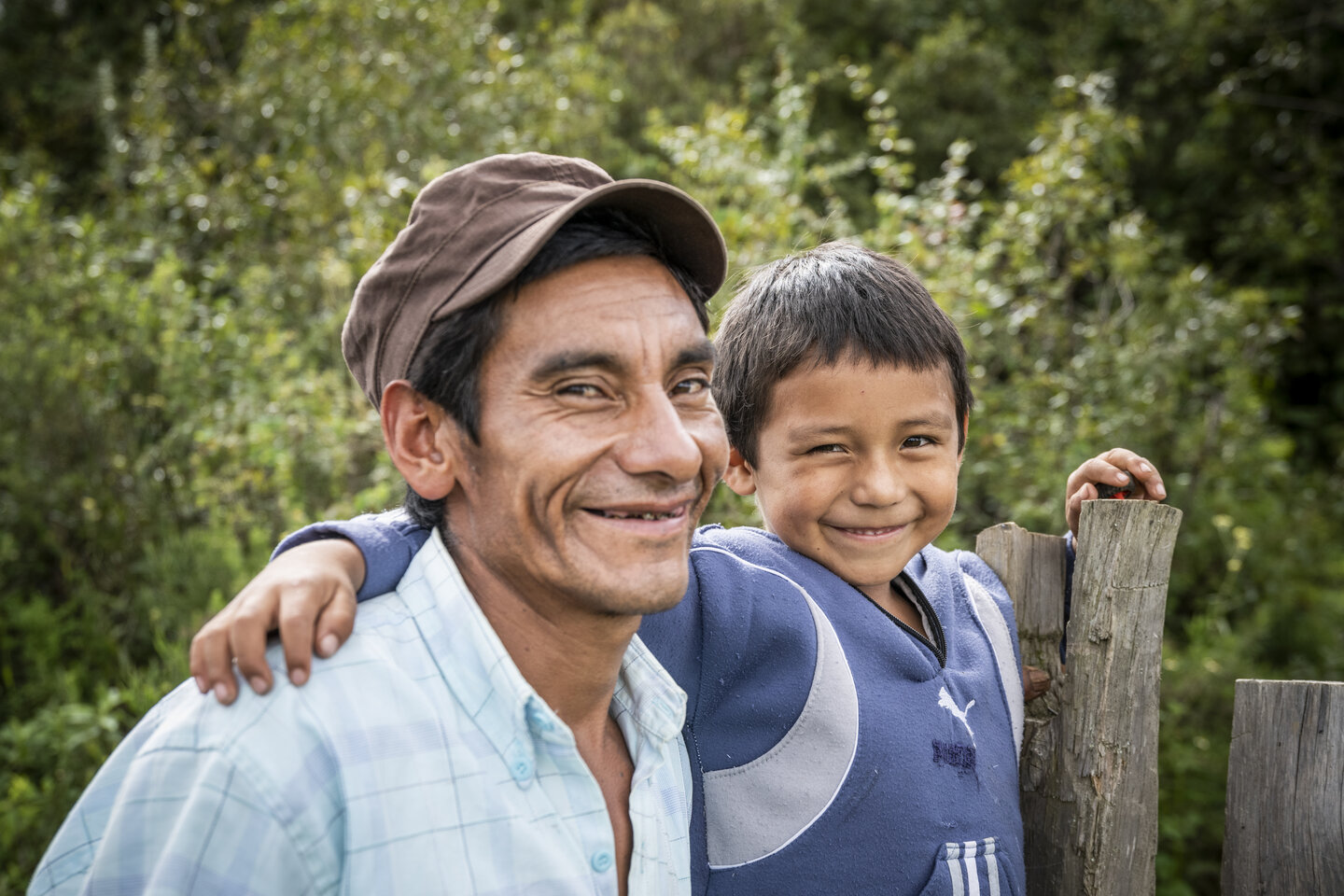He is so committed to protecting the place in the hills where the healthy water comes from that a small natural paradise has developed where no trees are felled anymore.
"This here is my brook," says Teófilo Garcia Caraballo and points with his hand to an inconspicuous, half-overgrown gully on the soft forest floor. All around us, birds I've never heard before sing, and from the gully comes the barely audible trickling of flowing water. Teófilo looks up and points with an outstretched arm to the trees, the forest and to the slope over the creek where I suspect there is open land behind the trees. "That is my cuenca," he adds and checks the visitor's reaction, but really he already knows the positive impression his work makes. The water pipelines, the irrigation system for his fields and the measures to protect the cuenca are an impressive testimony to his initiative and his hard work.

Cuenca means basin, well or valley. Cuenca also means source area or – somewhat cumbersome – water catchment area. In Villa Serrano, a rural municipality about 200 kilometres away from Sucre, the country's administrative capital, Helvetas is carrying out a project to maintain and preserve catchment areas just like this one.
Teófilo took me on his motorbike to his finca in the hills. As we set off in the municipality's main village, you could hear toads in the small river down below. It sounded as though hundreds of pieces of light resonating wood were knocking against each other. We travel over reasonably good roads, over brooks and small bridges, up and down into the hills, whose summits are covered in a thick layer of fog. We overtook two farmers on their way to their fields.
With their short-handled hoes on their shoulders, they leisurely stood to one side as they heard the motorbike. They were the only people we encountered along the way. After a journey of about an hour, Teófilo left his motorbike at the side of the road. He opened up a gap in the barbed-wire fence and I followed him into his realm.
A protective fence for the water
The path is lined with pines he planted himself. There are drops of night-time rain or dew on the long needles. In the morning twilight between the fog and the, by now, open skies, everything is bathed in a magical blue light. "Two hectares," he says. "That's how much I've fenced in." Last year, he drove poles into the ground at regular intervals and spanned barbed wire in between. He put up a fence almost one kilometre-long in this way.
It was a Helvetas course that prompted him to protect the cuenca. Teófilo García Caraballo is 37 years old, small, wiry and with a smile on his face that I don't know whether it comes from an inner happiness or from a mocking forbearance of the foreigner standing raptly in front of him in this almost fairytale-like world. "Previously, everything was open here," he says and describes how cows and sheep soiled the brook when they drank from it, and how they damaged the young trees. "They can no longer enter the forest now. The brook remains clean and the young trees can grow unhindered."
Teófilo García Caraballo, 37, farmer
He only uses deadwood, wood that has died naturally or branches. In just a few years' time, any wood he needs for building timber or firewood will come from the small pine plantation he planted above on the way.
While we are going through the forest, Teófilo twice bent down to the hidden brook. The first time was to clean the simple supply of drinking water, which leads from a hose to his house. The second time was to show me the supply for the irrigation line.
A water pipeline can change your life
"Water is a blessing," said Inés Caraballo Padilla, Teófilo's mother, the evening before. We sat in the dull light of a weak light bulb in her bedroom, which doubles up as her kitchen. "Ayyyy," the 76 year-old kept saying. "Ayyyy!" A long, high-pitched cry, which is used mostly by the older people here when they want to emphasise information or strengthen a feeling. "Ayyyy!" In the past, they put buckets and bowls under the edge of the roof to catch the water during the rainy season.
In the dry season, they drew the water from ponds or from shallow streams, some located a long way away, some a bit closer. And – ayyyy! – if the dry season was particularly bad, they had to walk up to an hour away. "Sometimes I collapsed. Sometimes a clay pot broke," said Doña Inés. She spoke a slurred Spanish I could barely understand, and I looked questioningly again and again over to her niece. She repeated what her aunt had said and formulated my questions so they could be relayed to the old lady. "Ayyyy!" said Doña Inés. "We drank from the same holes as the animals."
Since her son built a drinking water pipeline, the farm now has water the whole year round, and because a fence keeps the cattle away from the cuenca, the water stays clean. They also have enough to irrigate the farmland. "Ayyyy! Before, we had no fruit and hardly any vegetables. But now we have apples and peaches, and we can grow vegetables," said Doña Inés. "The water pipelines have changed our life."
In Bolivia's rural regions, 30 percent of people still live without access to clean water. The poorest regions of the Altiplano greatly exceed this figure. Here, at 4,000 metres, where the sun relentlessly burns down from the skies by day and where temperatures at night can fall to below freezing, there are hardly any trees or forests to help the ground save water.

Most streams have already dried out, just a few weeks after the rainy season, and the women and girls set off to nearby, and later ever-more-distant, water holes. In highland villages that are particularly affected, Helvetas finances reservoirs to catch roof water during the rainy season and save it for a few months.
Eager for new ideas
In the area around Villa Serrano, where Teófilo's family live, Helvetas is supporting a different type of water project. Here, at between 2000 and 2500 metres altitude, it is about protecting small wooded areas with ground that stores rain water like a sponge and then slowly releases it again during the dry season. These small catchment areas are in danger. The temptation for the farmers to fell the valuable trees is huge, whether it be to use the wood or gain pasture land. Here, Helvetas supports farming families who invest in the future and protect their small wooded areas, and maybe even want to extend them.
The exact plans for this – reforestation and protective fences in wooded areas, terraces and sump ditches in open areas – are drawn up by the local residents themselves, since no-one knows the local situation and needs of the community better than they do.
Teófilo has meanwhile taken me to his finca. The first thing he does is to open the drinking water tap and show me where the drinking water pipeline goes that he laid a few years ago. Then, he shows me the new irrigation pond. The Helvetas course not only gave him an understanding of how to protect his cuenca and plant his trees, it also gave him the idea of setting up an irrigation system for his plantations.
The central element is a pond that collects the water from the small brook, which carries very little water in the dry season. In order to protect this pond, Teófilo not only put up a fence, he also built a clay wall up to above-head height. An elaborate structure rhythmically punctuated by peep-holes, which blends harmoniously into the countryside. A structure that vividly shows how valuable water and irrigation is to him.
Teófilo's plantations are located just a few metres below the pond: the barley and potato fields, the beginnings of a vegetable garden, the earthen terraces with apple and peach trees. I pick a small apple. It has firm, succulent flesh with an intense, sweet and sour taste. The idea to plant fruit trees also came from the Helvetas course.
Teófilo is eager for new impetus and farming techniques and therefore regularly attends courses by government departments or NGOs. If he sees something there that makes sense to him and catches his interest, he finds out all the information and gets to work at home as quickly as possible. "If I don't set about the task straight away, the idea fades and I end up letting it go," he says. "You can only really know what you put into practice."
You can't move forward without taking risks
In the meantime, the sun is already high up in the sky. In order to avoid the scorching rays, we go into the inner courtyard of the finca and sit ourselves down in the shade of a wall. Does it not get a bit much for him sometimes to constantly grapple with new ideas? "Look," he says and draws lines in the dust with a stick. It soon comes together into a rudimentary map. "That is the cuenca. The small brook with the water catchments is there. The pipelines to the house and the irrigation tank are there. And the pipeline network for the drip irrigation is there." He built and set up all of that over the last few years. Step by step, he is drawing closer to his dream of transforming little-used land into a green oasis.

Teófilo is aware that not everyone is as proactive as him and that too many wait for the government or an organisation, rather than knuckling down themselves. "Most people are not keen on taking risks. They just want what they know, even if it hasn't proved its worth," he says. "If you don't take risks, you won't learn and you can't progress."
I ask him whether he's ever lost courage. A few years ago, he says, he really did think about giving it all up, selling the land and cattle and moving to Santa Cruz, to the booming city in the subtropical south-east of the country. But then he had the idea of protecting the cuenca and irrigating. Teófilo and his family stayed. His wife, he says, is similar to him: "curious and brave". And has he ever failed? His answer reminds me of a well-known quote from Winston Churchill. Teófilo García Caraballo says:
Teófilo García Caraballo, 37, farmer
That is what he learnt from his father. "He wanted us to stay attentive and always learn something new," says Teófilo. And that is exactly what he wants to pass onto his two sons as well. For a long time, he hoped his 17-year old son, Yamil, would go to agricultural college and keep developing the finca with him.

But Yamil followed through with the idea of seeking out something new and signed up to do an apprenticeship as a car mechanic. Six-year-old Rilberth doesn't have any career plans as yet, or if he does he isn't giving them away. He sits there pretty much in silence. I ask him about the water pipeline and the water in his glass. That, he says, is nothing new; it has always been there.











